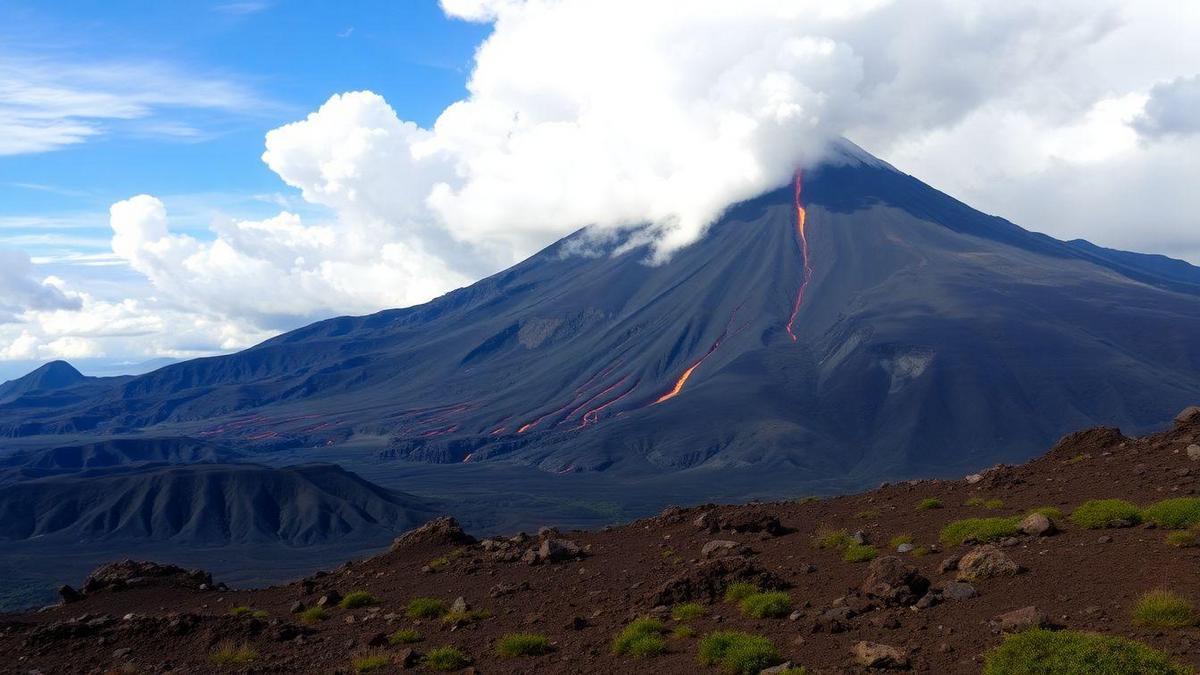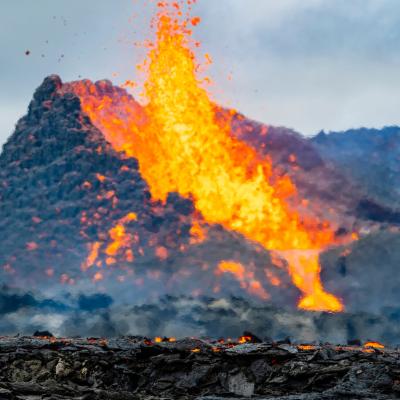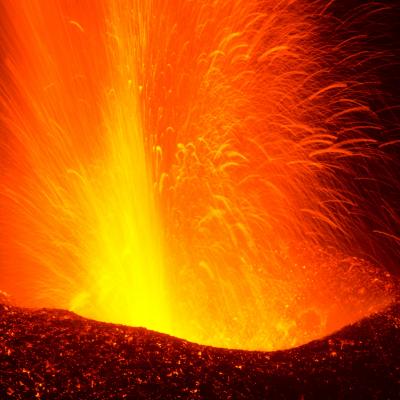Anúncios
Volcanic eruptions are impressive natural phenomena that result in the release of magma, gases, and ash from the Earth’s interior. These events are caused by a complex set of geological processes, involving everything from tectonic plate movements to the composition of magma. Studying these mechanisms is essential to understand the dynamics of our planet and the dangers that eruptions may pose.
Understanding volcanic eruptions goes beyond basic science, impacting areas such as natural disaster prediction, environmental management, and the safety of communities around volcanoes. Through research and technological advancements, scientists seek to unravel the mysteries behind these events, creating ways to mitigate their effects and improve the preparedness of populations. This study continues to reveal crucial information about the Earth’s geological history and its internal processes.
Anúncios

Types of magma and their influences on eruptions
There are different types of magma, each with its own characteristics that affect the behavior of eruptions. Basaltic magma is the most common type, with low viscosity and rich in iron and magnesium. This allows it to flow easily, resulting in effusive eruptions, with fluid lavas that spread over large areas.
Andesitic magma, found in subduction zones, is more viscous and contains more silicon. This makes it harder for gases to escape, leading to more explosive eruptions with the release of ash and rock fragments. These eruptions can be very dangerous because their pyroclastic flows can reach high speeds.
Rhyolitic magma is the most viscous, with a high concentration of silica. It is responsible for some of the most violent and catastrophic eruptions. Due to its high viscosity, rhyolitic magma forms large lava domes and can result in extremely explosive eruptions, causing severe damage to surrounding areas.
Each type of magma has a direct impact on local ecosystems. More explosive eruptions, such as those from andesitic and rhyolitic magma, tend to cause immediate destruction, while calmer eruptions, such as those from basaltic magma, may have a more gradual impact on the environment but still cause extensive damage over time.
The importance of eruption monitoring
Constant monitoring of active volcanoes is essential for natural disaster prevention. Modern technology allows early detection of signs indicating an imminent eruption, such as seismic tremors and changes in ground behavior. This enables the early evacuation of at-risk areas, saving lives.
The use of satellite imagery and ground sensors also helps identify deformations in the Earth’s surface. These deformations can be signs of accumulated pressure inside the volcano, which often precedes an eruption. Additionally, gas emissions, such as sulfur dioxide, can be monitored to indicate volcanic activity.
These monitoring data are analyzed in real-time to predict the volcano’s behavior. With this information, scientists can issue alerts and provide recommendations on how communities should prepare for the eruption. The rapid dissemination of information is vital to minimize damage and protect the population.
Furthermore, continuous monitoring allows for a better understanding of volcanic activity cycles. This contributes to the development of more accurate predictive models, which can be used in future eruptions. Constant improvement of these technologies is crucial for mitigating risks associated with volcanic activity.
How volcanic eruptions work and their complex geological mechanisms

Volcanic eruptions are some of the most powerful natural phenomena on Earth, characterized by the expulsion of magma, gases, and ash from the Earth’s crust. The underlying mechanisms that lead to these eruptions are complex and involve a variety of geological processes. At the core of this phenomenon is magma, formed by the melting of rocks in the mantle and crust due to high temperatures and pressures. This molten rock can rise toward the surface, creating pressure that eventually leads to an eruption. The dynamics of magma formation, its ascent, and the subsequent eruption are influenced by various factors, including the composition of the magma, the volcano’s structure, and the surrounding geological environment.
The behavior of volcanic eruptions can vary significantly depending on the type of magma involved. For example, basaltic magma, which has low viscosity, allows gases to escape easily, resulting in relatively gentle eruptions. In contrast, more viscous and gas-rich magmas, such as andesitic and rhyolitic magmas, can trap gases, leading to explosive eruptions. The interaction of these geological factors creates a wide range of eruption styles, from effusive lava flows to explosive pyroclastic flows. Understanding these mechanisms is crucial for predicting volcanic activity and mitigating the risks associated with human life and infrastructure.
Advantages of understanding volcanic eruptions and their complex geological mechanisms
Having a comprehensive understanding of volcanic eruptions and their geological mechanisms offers numerous advantages, especially in the areas of disaster preparedness and environmental management. First, by studying the patterns and processes associated with volcanic activity, scientists can develop predictive models that help forecast future eruptions. This predictive ability is invaluable for communities living near active volcanoes, as it enables timely evacuations and the implementation of safety measures, potentially saving countless lives.
Additionally, understanding the geological mechanisms behind volcanic eruptions can aid in assessing volcanic hazards. By identifying the types of eruptions a given volcano is likely to produce, scientists can better inform local authorities and residents about the risks involved. This knowledge can also guide land-use planning and development in volcanic regions, ensuring that infrastructure is built with appropriate safety measures in mind.
Furthermore, the study of volcanic eruptions contributes to our broader understanding of the Earth’s geological processes. Volcanic activity plays a significant role in shaping the Earth’s surface and influencing climate patterns. By analyzing the gases and materials released during eruptions, researchers can gain insights into past climatic conditions and the long-term effects of volcanic activity on the environment. This information is crucial for understanding the Earth’s history and for making informed predictions about future geological events.
Finally, understanding volcanic eruptions can have significant implications for scientific research and education. By engaging with the complexities of volcanic activity, scientists can foster a greater appreciation for Earth sciences among the public and inspire future generations of geologists and environmental scientists. This knowledge transfer is essential for cultivating a society better equipped to handle natural disasters and environmental challenges.
How to study volcanic eruptions and their complex geological mechanisms
Studying volcanic eruptions and their complex geological mechanisms requires a multifaceted approach that combines fieldwork, laboratory analysis, and advanced technology. Here are some key methods used by researchers in this field:
- Analyze magma formation and its role in eruptions: Understanding the processes leading to magma formation is essential for studying volcanic eruptions. Researchers analyze the mineral composition and chemical properties of magma samples to determine their origins and the conditions under which they formed. This information can provide insights into a volcano’s potential behavior during an eruption.
- Investigate tectonic plate movement: Tectonic plate movement is a primary driver of volcanic activity. By studying interactions between these plates, geologists can identify areas of increased volcanic risk. Techniques such as GPS measurements and seismic monitoring help researchers track tectonic movements and assess their relationship with volcanic eruptions.
- Observe volcanic activity and its patterns: Continuous monitoring of volcanoes is essential to understand their behavior. Researchers use a combination of satellite imagery, ground sensors, and aerial surveys to observe changes in volcanic activity, such as ground deformation, thermal anomalies, and gas emissions. These observations can help identify signs of imminent eruptions.
- Measure lava viscosity and its effects on eruptions: Lava viscosity plays a critical role in determining the style of an eruption. Researchers conduct laboratory experiments to measure the viscosity of different types of magma under various conditions. Understanding how viscosity affects lava flow and gas release allows scientists to better predict the nature of volcanic eruptions.
- Monitor pyroclastic flows and their hazards: Pyroclastic flows are among the most dangerous volcanic phenomena, capable of traveling at high speeds and causing widespread destruction. Researchers study the dynamics of pyroclastic flows through field observations and modeling techniques. Understanding their behavior is crucial for assessing risks and developing evacuation plans for affected communities.
- Study volcanic gas emissions and their environmental impact: Volcanic eruptions release a variety of gases, including sulfur dioxide and carbon dioxide, which can have significant environmental and climatic effects. Researchers monitor gas emissions to assess their impact on air quality and climate change. This research helps inform public health policies and environmental regulations.
By employing these methods, researchers can develop a comprehensive understanding of volcanic eruptions and their complex geological mechanisms. This knowledge is essential for improving disaster preparedness and mitigating the impacts of volcanic activity on communities and the environment.
Did you enjoy learning about volcanic eruptions and their complex geological mechanisms?
Learning about volcanic eruptions and their complex geological mechanisms is not only fascinating but also critical for understanding the dynamic nature of our planet. The intricate processes that lead to these powerful events reveal much about the Earth’s interior and the forces that shape our environment. By delving deeper into this subject, we gain valuable insights that can help protect lives and preserve ecosystems.
As we continue to explore the complexities of volcanic activity, we discover new knowledge that can enhance our preparedness for future eruptions. The more we learn, the better equipped we are to face the challenges posed by these natural phenomena. Engaging with the science of volcanology opens doors to a deeper appreciation of our planet and its geological wonders.

Frequently asked questions
What causes volcanic eruptions?
Volcanic eruptions are caused by the movement of tectonic plates. When these plates collide, pressure builds up. This can cause magma to rise and explode.
What are the types of volcanic eruptions?
There are several types! The main ones are explosive eruptions and effusive eruptions. Explosive eruptions release ash, while effusive eruptions release lava.
How is magma formed?
Magma is formed when rocks inside the Earth melt. This happens due to heat and pressure. It’s like the rock is cooking!
What is the impact of eruptions on the environment?
Volcanic eruptions can cause great damage! They can release ash, gases, and lava. This can affect air, water, and even climate.
Are volcanic eruptions and their complex geological mechanisms dangerous?
Yes, they can be very dangerous. They can cause landslides, tsunamis, and even affect people’s health. It’s important to stay informed!
